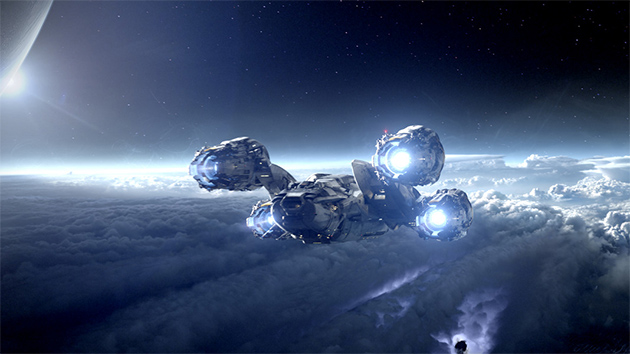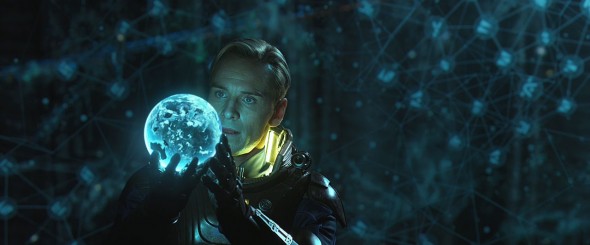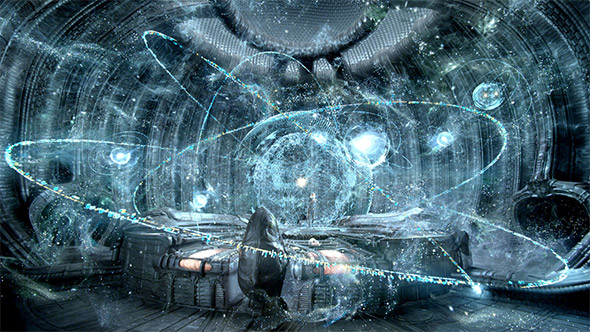On Grading Red Raw, Reading Ridley-grams, and Planning Gore for the R Rating — and Possible PG-13
Richard Stammers, nominated for an Oscar for his VFX work on Prometheus, joined the Moving Picture Company (MPC) as a digital compositor for the 2001 film Harry Potter and the Sorcerer’s Stone after working as a compositor and visual effects supervisor for broadcast television productions. At MPC, he became a visual effects supervisor with the 2003 film Calendar Girls. He now has 16 film titles to his credit, including The Chronicles of Narnia: Prince Caspian, The Da Vinci Code, and Harry Potter and the Goblet of Fire. In 2011, he received a VES nomination for supporting visual effects in Scott’s Robin Hood.
His fellow Oscar nominees are special effects supervisor Trevor Wood, MPC visual effects supervisor Charley Henley, and Weta Digital visual effects supervisor Martin Hill. Stammers, Wood, and Henley also received a BAFTA nomination along with Fuel visual effects supervisor Paul Butterworth. The Twentieth Century Fox film also received a nomination for excellence in production design from the Art Directors Guild. The visual effects Oscar and BAFTA nominations for his work on Ridley Scott’s Prometheus are his first. We talked to Stammers on the release of Prometheus last year, and checked back in with him on the occasion of his Academy Award nomination.
F&V: Why do you think your peers voted for the visual effects work in Prometheus?
I think the level of quality of the work is particularly high. I could argue that because of the project and the director, everyone was aware of the importance of raising the bar and doing the best work they could.
F&V: What do you think contributed to the high quality?
Everything was grounded in reality. The whole approach to shooting was to start with something real. We based the exterior planet shot on exteriors in Iceland, and even though we replaced most of it, we could match to photography. The interior sets and lighting provided by the DP and production were fantastically beautiful, so we were adding to stuff that was already great. The creatures – we would take over when the other teams exhausted their possibilities. The great combination of so many efforts in so many departments working in tandem gave us a consistent flow and even aesthetic through the whole film. I think Prometheus stands out for the level of realism.
F&V: Was there a different feeling overall about this project?
The process was very different. There was definitely a feeling that this has to be excellent. The visuals have to be spot on. It was never anything you put a finger on. Ridley was just making a good film in the way he wants to make a good film working from years of experience as a great filmmaker. What he brings to the table is stunning. We had to make sure we were in line with that expectation.
F&V: It sounds like the visual effects crews spent a lot of time matching and extending practical effects and sets.
Ridley’s [Scott] approach is to do as much in-camera as possible. He’s prepared to go only so far with visual effects. If it’s at all possible, he tries to do the shot practically. Prometheus is probably one of the biggest visual effects films he’s done. Robin Hood had 1100 or 1200 shots, so Prometheus with 1400 shots was similar. But it had the largest amount of complex work, which reflects on how much practical stuff Ridley tried to do. We’d work things out with the creature supervisor so Ridley could direct as much as possible on set and then we’d take over digitally. We had to intercut with the creature department.
We did the tentacle creature entirely digitally, though. Weta based little details inside on real living creatures.
F&V: What about the disgusting bits?
Ridley loves his gore. It’s interesting. You become quite numb to it during the process. We previs’d the medpod sequence as R-rated and PG-13-rated and made sure, when we were shooting, that we shot plates that would be less gory. But, Ridley loves his blood — pints and pints of blood being poured. In a couple sequences, we had to reduce it to keep the continuity of a PG-13 version. I’m amazed we got away with what we did.
He would revel in those moments like in Alien, when the egg opens up and shoots out into John Hurt’s face. They did that with a pig’s bladder or intestine — a tube of offal they put an air line into. A blast of air sent entrails into John Hurt’s face for eight frames. We tried to get the same things to happen and we might find one little moment Ridley could edit into. But we didn’t use any real animal parts on this film, which was kind of disappointing. Technology has come a long way. Neal Scanlan [creature and special makeup effects supervisor] created things with nice disgusting qualities, and we had the opportunity to add details.
F&V: Was the medpod sequence the hardest shot?
I think the hardest sequence was where the engineer drinks the black liquid and his body decomposes and decays to a component level of a DNA strand. You go inside the body and see the DNA come apart and reform. In stereo. Weta took on those incredibly challenging shots. The design process made it harder; it was subjective. We were getting close to delivery and one of those shots took a week to render. If anything had to change, we would not have met the delivery date. But Weta did a great job.
Every part of that sequence was creatively challenging. The decay before [the DNA part] started with an actor in prosthetics. That shot transferred into a full digital version and, as with other creatures, we cut between the digital and practical and you can’t see the difference.
We had to do a lot of adapting of current tools. The CG characters had pale translucent skin that was not like human skin. Weta had issues with the engineer and MPC with the creature. The silicon aesthetic was completely different from human skin.
F&V: Was it an advantage to have so many studios working on the film?
It has its pros and cons. The volume of effects on the films I worked previously on was such that I felt I could have absolute control over everything. This was so big I could steer, but it was impossible to keep my finger on everything. I had to rely on the other vendors and their supervisors and allow people to do what they do really well. You have to make the right decisions early on and then rely on the people you have around you to do the work.
The downside is that it takes meticulous organization to make sure you have time to talk to each of these people. We based the post-production in L.A., but we had studios working in London, L.A., New Zealand, and Australia. So we had email traffic 24 hours a day, six days a week. We had a good team that coordinated and made sure everyone got the information they needed. It was a complex management task.
The biggest advantage is that each studio had its own supervisor — exceptionally talented people focused on giving you the best work they can. The spread of their studio’s creativity is concentrated on the section they’re looking after. They have your back in terms of that section of work.
F&V: How did you keep the color consistent among the 10 studios that worked on visual effects?
We had a good and simple color pipeline. At the beginning we invested a lot of time talking to Dariusz Wolski, the DP, and Company 3. We made sure everyone got their say and rolled that into how we approached color. The output from the Red camera was quite raw in terms of what we worked with. Darius didn’t grade the rushes or dailies, so we were blessed. The only adjustment on the raw files was a slight contrast adjustment. And, we had a look that we and Company 3 were happy with. Every step of the way, from dailies to editorial to visual effects vendors, everyone had a color pipeline that matched. When Ridley got into DI, we didn’t want him to have the shock of seeing something that didn’t look like the rushes. On Robin Hood, we had that. But shooting digital eliminated that whole problem we had in film shows.
F&V: So, did you spend hours every day sitting in a dark room looking at a monitor?
Yeah, I spent a lot of time reviewing. When we dropped a shot into a cut, we looked at it in stereo and did a proper screening with Ridley in the DI suite. We’d sort out time to work with his colorist and grade all the visual-effects shots. When he goes into the DI for the final grade, he does a lot of playing around and he wants to see the visual effects shots in that context. He likes to tinker with every shot. It was an in-process DI, the equivalent of taking the director to a screening room. He would do extreme grades to see how far he could go. There were shots on the planet surface that he wanted to treat further than what MPC supplied. He’d make the clouds more defined. He wanted to see how far he could push it, and if he couldn’t push it far enough we’d send it back. He loves the crispness of the digital look. He’d sharpen it further in DI.
F&V: In what ways is working with Ridley Scott different from working with other directors?
He’s an incredibly visual director. He’s an artist. He paints and draws regularly. When you ask him a question, the answer, whether it’s simple or complex, usually is in conjunction with a drawing. That was incredibly important for the progress of the story and the look of the film. Knowing what the director wants is half the battle for any time something is hard to describe. He would sketch with a marker or a pen. On set, he’d say, “Someone give me a piece of paper.” He’d draw on the backside of script pages. Any bit of paper. If I couldn’t take it from him, I would take a photograph. We kept scans in our database and sent them to the vendors. In some cases, they were incredibly helpful. We called them Ridley-grams.
F&V: What was your reaction when Scott offered you the job?
It was, “Oh my god.” When Ridley made the decision to have me oversee this project, I was stunned. I’d worked with him on Robin Hood, and we had got on well. But, Prometheus was a bigger deal. Huge in terms of project complexity and expectations. I was happy to take on the role, but it was a scary thought. Always in the back of my mind, I knew this was special. The expectations from the fans, the filmmakers, my colleagues who’d say, “Oh my god, you’re working on a Ridley Scott science-fiction picture.” And, originally, it was talked about as a prequel to Alien. The excitement was amazing. I had to approach the show as, “We are doing a movie. We will do our best job,” and try not to think about the expectations.
F&V: And now?
To be nominated for an Oscar and BAFTA award at the same time is a great honor. It’s exciting.
Crafts: VFX/Animation
Sections: Creativity Technology
Did you enjoy this article? Sign up to receive the StudioDaily Fix eletter containing the latest stories, including news, videos, interviews, reviews and more.













Leave a Reply